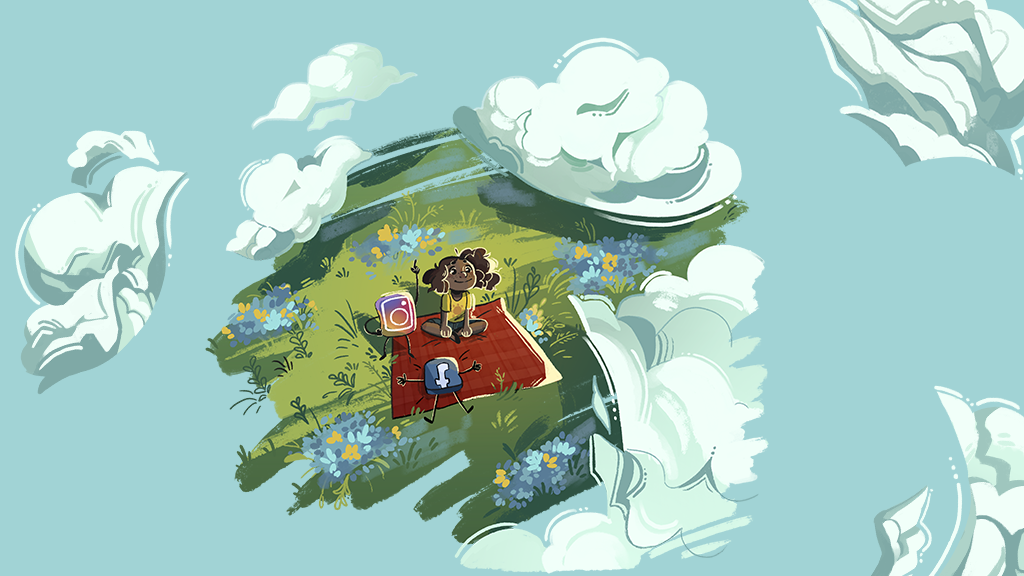The public perception of social media seems to have become more negative in these past few years. However, as spring approaches many of the more outdoors-inclined are preparing their hiking boots and camping gear, some perhaps packing their lenses and tripods to get that perfect mountaintop selfie. It is becoming increasingly apparent that social media is becoming a catalyst for many to get outside and enjoy the world around them.
As a Motivator
For some, social media is all about sharing experiences. Whether in the form of pictures, text, videos or other media, it's one of the reasons many partake in them to begin with.
“If you were to look at my Facebook, you'd find that a lot of what I post is probably related to outdoor-type things,” said Seann McArdle, assistant director of Wellness Education.
"A lot of what I post is probably related to outdoor-type things."
Using social media in this way can provide motivation to get outdoors through sharing those experiences, validation and the satisfaction that comes with it. However, it is also important not to lose sight of the real reasons one is engaging in outdoor activities, so as to maintain intrinsic motivation and not become overly reliant on external rewards.
"They're a trophy to say, 'Hey look at how fast I did this,' or 'Look how much fun I had,'" said McArdle. "The reality is, you gotta have that fun first, you gotta put that workout in first. That should hopefully be the driving force.”
Though, if one is using social media as an external motivator, such motivation can be made intrinsic.
“Social media is all about external motivation, it's about looking at something and thinking, 'Man I really want to do that,'" McArdle said. "But you have to internalize it and have it become intrinsic. It has to become something that inspires you.”
"You have to internalize it and have it become intrinsic."
As a Tool
Social media has become a standard part of advertising, with companies and influencers abound, selling clothes, equipment and experiences.
“I think it’s a very strong form of media that influences people for sure,” said Anne Brewer, owner of LOCALadk Magazine. “Advertisers like to know and see that I have a social media presence, and that the magazine has a social media presence … So right there you have advertisers who are interested in being on social media as part of their media mix.”
While some may be uncomfortable with such marketing tactics, they are effective both at selling products and a lifestyle of outdoorsmanship. However, the posts of such outdoorsy influencers can come off as disingenuous to some who consider themselves more deeply involved in the outdoorsing community.
“It seems forced,” said Brewer. “I’ve actually seen it and been … a little disappointed, I’m like 'oh that’s a cool page to follow, I like that person she’s got really cool posts, got some good information,' but then [I see] the product placement."
Though Brewer and many others may find product placement in social media posts distasteful, there is something to be said for respecting the hustle.
"I respect what she’s doing, and I respect that she’s created a business for herself, that she has good intentions," said Brewer.
Ultimately though, do the intentions of the poster alter the effect such a post has on those who see it, or the community that said influencer is a part of? Or rather, is it the content of the post that matters?
“As long as they're just out there in the world doing it, and their messaging is positive," said McArdle, "I think that's still a positive.”
As a Community
Social media has allowed for the formation of communities both local and global surrounding outdoorsmanship, which were never possible in the pre-internet age.
"As a local example, we have the Rochester Cross Country Ski Foundation, which manages a website and a Facebook page, so people are regularly jumping on there to discuss or post things,” said McArdle.
Feeling like a part of a community is a major reason some share their outdoor experiences and advice on social media. Thus, social media in the sense we think of it now can also provide resources to those seeking to engage in outdoor activities.
“From the responses we get from our social media posts it’s clear people are asking questions about the area, responding that they’ve gone somewhere based on seeing it on social media,” said Brewer.
While not typically what we’d associate with social media, forums can also provide a centralized hub for such communities. These hubs allow people to ask questions and share knowledge.
These resources can be useful when researching potential outings, to avoid issues that may be created by becoming overly reliant on social media as a motivator. Brewer warns this can lead to potential dangers, like getting lost, when one becomes tunnel visioned on getting that perfect picture.
“They’ll see a photo that everybody knows, and they’ll want to be there, and they want that photo. They’ve done zero research on what it takes to get to that spot,” said Brewer.
While it is always advisable to do one’s due diligence, there is something to be said for just getting out there.
“Really the best thing anyone can do to get started is just to go out, check out your local whatever it is —
As spring dawns and you're looking for inspiration to get outside, take that hike you've been meaning to take. Go see the Adirondacks or the Finger Lakes. Perhaps opportunities will present themselves to get outside and snap a few photos for social media.









